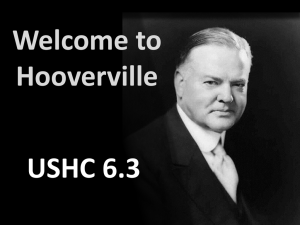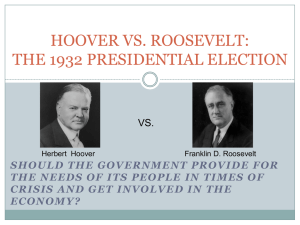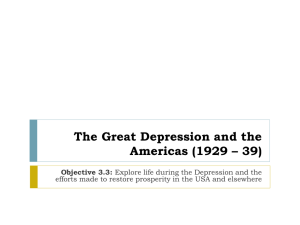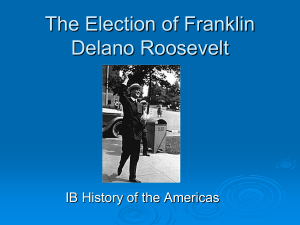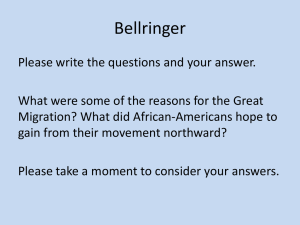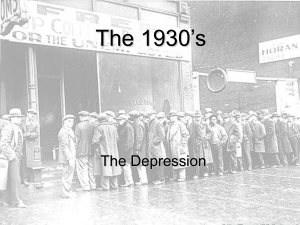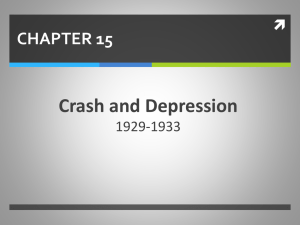Social Studies 11 Chapter 3
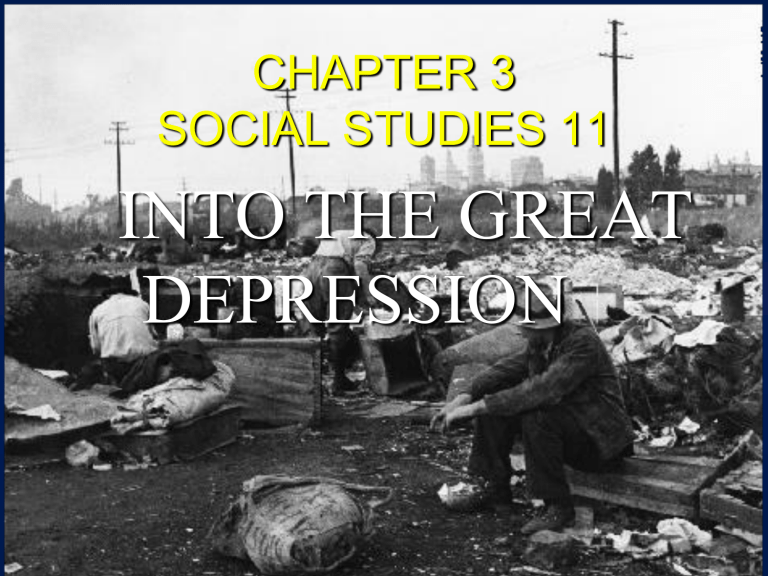
CHAPTER 3
SOCIAL STUDIES 11
INTO THE GREAT
DEPRESSION
GROWTH AND
DISCONTENT
With the war over, 250,000 Canadians hunt for jobs.
Unions had grown during the war but times were now tough.
One Big Union was promised by labour leaders (a Canadian Russian
Revolution)
General Strike in Winnipeg spreads to Vancouver
UNREST
June 21, 1919, Bloody Sunday in
Winnipeg.
Labour union membership began to drop.
Wheat prices fell from $3.15 to $1.11 per bushel (Morton, 1988, p.70)
Interest rates were raised to stop inflation.
C.N.R. freight rates raised. Maritimes hammered.
HALIBUT TREATY
1923
First treaty Canada signs on her own.
With the U.S.A.
Shows independence
THE KING BYNG
CONFRONTATION
Lord Byng, Governor-General of
Canada, refused to dissolve parliament after King’s ministers were implicated in an alcohol smuggling scandal.
King attempted to avoid the responsibility of a corrupt government.
Meighen takes office
The Wall Street Crash
Stock Prices rose
Investment trusts compounded the inflation of the stocks.
PRIME MINISTER BENNETT
King, “Not a five cent piece to provinces led by Conservatives.” “Unemployment is a provincial problem.”
1930 King out. Bennett in
Bennett brings in the highest tariffs since
1879 (Morton, 1988, p.81)
Bennett created the Bank of Canada.
President Herbert Hoover
the government knew that the market was about to crash. Even a newly published weekly called
NEWSWEEK predicted a stock market crash.
The government did not get involved because it was not its job
(Capitalist Gov. = hands off business.) and anything the government said could cause the crash
Oct. 24, 1929 (Black
Thursday)
Stock prices crash.
J.P. Morgan and others try to instill confidence in the market by buying millions of dollars worth of stocks. The market settles.
Oct. 29, 1929 (Black Tuesday)
Market collapses. The "Great Crash" has occurred.
40 billion dollars disappeared from the economy. Any company investing in stocks lost that money. (banks, factories, individuals, and companies who had their money in bank that had been investing in marginal stocks)
Herbert Hoover - Capitalist
1930 Hawley-Smoot Tariff Bill Largest example of U.S. Protectionist.
large tariffs on imports to save U.S. Jobs.
World trade slows. Massive unemployment.
Hoover brings in Reconstruction Finance
Corporation. $2 Billion given to industry to create jobs. (Hoover will not give direct aid to unemployed - not capitalist). RFC a failure.
Hoovervilles spring up.
shanty towns.
Hooverblankets newspapers used as blankets.
1931 Hoover announced a moratorium
Moratorium on international government debts because both
Austria and Germany were close to financial collapse.
This sent other nations depending on these payments into chaos.
1932 Worst year of
Depression
25% unemployment
THE DUST BOWL
Bonus March(1932)
veterans of WW1 protest to receive benefits early.
Douglas MacArthur sent to put it down. Doug gets overly enthusiastic.
Uses tanks and cavalry.
Hoover can't admit he lost control of
MacArthur. Takes blame.
Franklin Delano Roosevelt socialist.
1932 wins election promising the American people a "New
Deal".
Uses line from H.D. Thoreau and states: "The only thing we have to fear is fear itself."
Roosevelt has a special session of Congress called
"The Hundred Days".
deals with the "Three R's" -
Recovery, Relief, Reform.
several Federal Agencies created.
Called "Bank Holiday"
only solvent banks reopen.
Federal Deposit Insurance
Corporation Created (FDIC).
Bank deposits (up to $1500) insured to instill confidence in banks.
Agricultural Adjustment Act:
output restricted/force prices up
production quotas
1935 unconstitutional.
National Industrial Recovery
Act:
same as AAA only industrial
restricted output
1935 unconstitutional.
Wagner Act 1933
trade unions protected.
National Labour Relations Act
(striking legal [2nd ND] 1935)
Tennessee Valley Authority
1st time gov. Went into direct competition with the private sector.
hydro-electric dams in 7 states.
supply cheap power to spur economic development.
Civilian Conservation Corps
young men given jobs in "makework projects"
direct involvement/handouts!
Works Progress
Administration.
"Make work"
included the arts.
La Guardia airport created.
Orson Wells "Black MacBeth" funded.
More handouts. -1935 2nd ND
Social Security Act 1935
old age pension/unemployment insurance/welfare.
1937 considered unconstitutional
Roosevelt threatens to increase Supreme
Court from 9 to 15, thereby bypassing the "9
Old Men" (creating a democratic dicatorship because anything Roosevelt wanted to do would be constitutional)
SSA stays / Supreme Court remains at 9
BENNETT’S PLAN
The New Deal
Make work projects
Bennettburghs
Bennett Buggy
MAJOR-GENERAL
A.G.L. McNAUGHTON
1932 McNaughton was put in charge of the RELIEF CAMPS
A man could be fed, housed and clothed for one dollar a day including 20 cents a day pay.
RIDING THE RODS
PROTEST THE RELIEF
CAMPS.
BIBLE BILL ABERHART
Led the Social Credit Party
The difference between what a man made and what he needed to live should be made up by the government.
The difference was called the
Social Credit.
J.S. WOODSWORTH
Founder of the Co-operative
Commonwealth Federation
1932
1933 Regina Manifesto
REGINA MANIFESTO
planned economy
control banks
ownership of essential services
labour code
publicly organised medical services
1937 Business Wants
Roosevelt and his socialist ways out of the economy.
economy appears strong
economy wants Roosevelt to close down his programs. He does.
Economy collapses.
1939 Threat of WW2 bringing the U.S.A. Out of the Great
Depression.
MAURICE DUPLESSIS
1936 became Premier of Quebec
Instituted PADLOCK LAW.
lock any building used for
“communistic” purposes
Used it to attack opponents.
THE END
